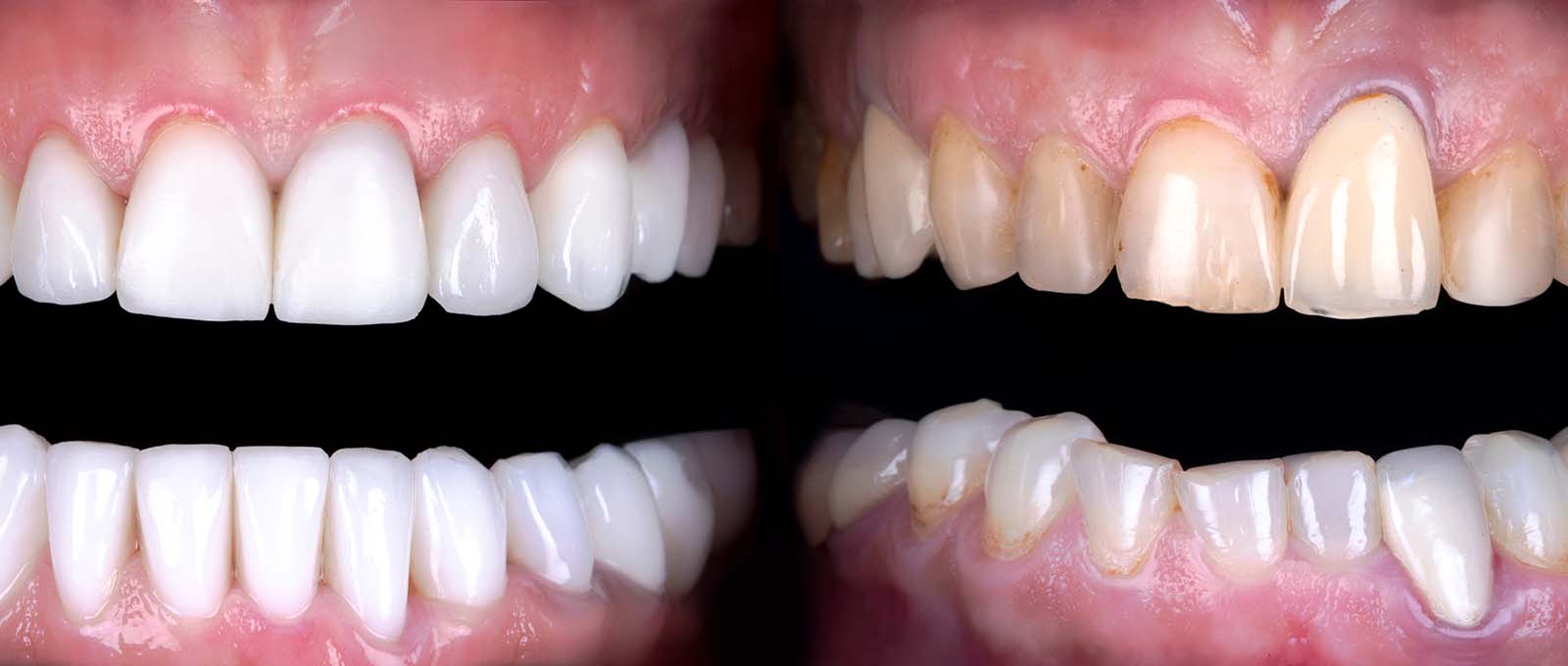Differences Between Veneers and Lumineers – 2020 Guide
So you are looking to improve your smile and protect your teeth from damages, here is what you need to know. Veneers and lumineers are trending as one of the most popular ways to improve your smile.
Veneers and lumineers are cosmetic procedures that can improve your smile and repair your existing dental flaws. Both can permanently align and whiten your teeth at the same time. However, there are differences between veneers and lumineers. The differences lie in the type of process and how they affect the surface of your teeth.
Both, however, can improve your appearance by making your dental flaws, such as cracks, crookedness and chip disappear. They can also address a number of dental issues, such as gaps, stains, discoloration, misshapen teeth, chipped or cracked teeth.
Everyone can benefit from lumineers and veneers if you are not happy with your smile. However, the ideal candidate should have healthy gums and teeth. Contact your local dental professionals for a consultation and evaluation.
What are Veneers?
A Veneer is a tiny prosthetic device, which is natural-looking, thin material, used by a cosmetic professional to restore and improve your smile. Before the application of veneer, your teeth will require preparation, which includes removing approximately 1/2 mm of the enamel from the tooth. The veneers are then glued to the tooth with resin cement to modify the shape, color and size of the teeth.
[ See: Porcelain Veneers Testimonials ]What are Lumineers?
Lumineers are a prosthetic device designed to be thin, similar to the ultra-thin contact lenses so that they can be placed seamlessly over the teeth to give you a beautiful smile. Lumineers do not require prep work, so damage to your tooth is minimized. Lumineers are ultra-thin can provide you with an attractive smile in different ways.
What is the difference between Lumineers and Veneers?
Veneers vs. Lumineers: Application
Veneer: The ideal thing about veneers is they can improve virtually every facet of your smile. Veneers can provide a stress-free way to permanently align and whiten your teeth and restore cracked or chipped teeth.
Veneers and Lumineers differences are veneers are made of tiny, natural-looking thin material, such as composite resin or porcelain. Before the application process begins, your dental professor will remove approximately .2mm to .5mm of the enamel and then the veneer will be bonded to the enamel of the teeth to give you an attractive appearance. The smooth surface will create an appearance that is natural, and to ensure the appearance of the teeth is not overly large or bulky.
Lumineer: Lumineers material is ultra-thin, durable and robust. Your teeth do not require prep work, such as drilling, reshaping or enamel removal. The procedures only require only two appointments to your dentist. Lumineers are placed directly over the tooth to give you a radiant smile, and your teeth will be left unchanged, and there will be no damage to your nerve or your teeth enamel.
Veneers vs. Lumineers: Material
Veneer: Veneers and Lumineers differences are made dental porcelain and composite. Composite veneers are placed directly over the teeth. Porcelain veneers are fabricated indirectly by dental technicians and bonded to the teeth with resin cement. Veneers are monochromatic in color, so that they can match your natural teeth easily.
Lumineers: Lumineers are ultra-thin, ranging from .2mm to .5mm in thickness. They are made from Cerinate porcelain and needs little or no tooth reduction, or numbing shots. Lumineer is a less invasive procedure compared to veneers.
Veneers vs. Lumineers: Pros and Cons
Veneers and Lumineers differences are outlined in their pros and cons. However, some issues can be fixed with veneers only.
Veneers:
Pros:
- Veneers can give your teeth a brighter, whiter appearance.
- Veneers can provide a more natural look because of a variety of shades.
- Gum tissues can tolerate veneer material.
- Veneers are resistant to stubborn stains.
- Veneer provides a variety of shades of color.
- Excellent option for chipped tooth repair
Cons:
- Veneers can be expensive due to the added prep work.
- The teeth and nerve can be damaged.
- The process is not reversible.
Lumineers:
Pros
- Do not require any prep work
- Less invasive
- Can make a strong bond to the enamel for longevity.
- No damage to the teeth or the nerve
- Lumineers cost less that veneer.
- Only two visits to your dental professional are required.
- Lumineers is ultra-thin to reduce the chance of bulkiness.
- Lumineers is reversible. If they are bonded permanently and correctly, you can take them off.
Cons
- Lumineers can appear thicker, chunkier and bulkier.
- For stubborn stain, Lumineer must be made thicker to hide the dark discoloration. This can make your smile appear bulky.
- Lumineer can not be used if your teeth are crooked or crowed because preparation and shaping are required.
Am I a candidate for Veneers or Lumineers?
Veneers and Lumineers are great dental treatments for many people. If you are con about cosmetic dental treatment, the below signs may indicate whether you are a good candidate.
You should be in good oral health, which means your gum and teeth should be healthy. Being in good oral health can help you better undergo treatments and make you an ideal candidate. Veneers and Lumineers differences are an ideal candidate for lumineers will be determined by the services of your teeth.
- You have a desire to fix stained or discolored teeth. Veneers and lumineers can hide stains or discoloration on your teeth that do not respond to teeth whitening treatments.
- You want to remove stains from your tooth with old fillings and tooth decay.
- You want to fix imperfections on your tooth. Veneers and lumineers can fix misshaped teeth, cracks and chips.
- You want to correct some previous cosmetic issues. Veneers and lumineers can straighten, whiten, and fix the shape of your teeth.
- You must have sufficient tooth enamel on your natural teeth so that when a small layer is removed, it will not affect the strength of the teeth. The surface of your teeth should have strong bonding area for the veneer.
- If your teeth are moderately straight, lumineers and veneers can fix slightly misaligned and crooked teeth. However, if the misalignment is severe, it can cause cracks in the veneers.
Habits to avoid
- You should avoid hard candy, biting your nails and gnawing on pens. These habits can damage the lumineers and veneers.
- You should avoid nighttime teeth clenching and teeth grinding as well.
You should floss and brush regularly and schedule appointments with your dentist regularly.
The best way to determine if you are an ideal candidate for lumineers and veneers is to schedule a consultation with your dentist.
Lumineers cost vs Veneers: Cost
Improving your smile will not improve your overall health, but it can improve your mental and emotional health. It can boost your confidence, self-esteem and make you feel good about yourself. Unfortunately, most people do not consider cosmetic procedure due to the cost. Veneers and Lumineers differences lie in the cost. Lumineer costs are cheaper
Veneers and lumineers average cost are between $800 and $2000 per tooth. Cost of veneers and lumineers can be influenced by several factors, such as size, geography and type of treatment. Your local dentist can give you the exact cost.
However, if you are a Los Angeles resident and you want to improve your smile, you can get free cosmetic dentistry consultation. Other options include your insurance plan, which may cover a portion of the cost depending on the procedure and the need.
Before your dentist gives you an estimate, you will receive an examination to access your overall health. This examination will help you decide whether veneers or lumineers are the right choices to fix your concerns.
You should consult your insurance provider to learn about your coverage. Your local dentist can also assist you with the process. They usually offer a variety of payment methods, such as Mastercard and Visa.
[ See : Porcelain Veneers Cost Los Angeles ]Free Cosmetic Dentistry Consultation for Los Angeles residents
Veneers vs. Lumineers: Other services
More than 90% of American tend to agree that our smile is a valuable asset, but only 50% are happy with their smile. Many people believe that cosmetic dentistry is a luxury procedure.
Some cosmetic procedures can be expensive, but there are ways to make the treatments less expensive, such as only covering the tooth that is visibly damaged. You can choose to change as much or as little of your appearance as you prefer based on your schedule and budget. Your appearance makeover can include a blend of cosmetic dental treatments. A beautiful can give you the confidence to pursue your goals.
Depending on your goals, your dentist can recommend comprehensive care that can last several months to simple procedures, which are just a couple of visits. There are several services available. Some of the other smile makeovers that can be provided by your local dentist professional include:
Veneers: Veneers are one the most popular dental procedures that can instantly hide gaps, chips, stains and alignments in a couple of visits.
Lumineers: Lumineer are non-invasive, and they cost less than veneers.
Porcelain crowns: These crowns are made from fused metal porcelain or luminescent porcelain. They can restore function and beauty to decomposed or damaged teeth.
Bonding: Bonding is a procedure to fill gaps and produce a balanced appearance. Bonding is not long-lasting procedures that require touch-ups periodically.
Teeth whitening: The whitening system can lighten your teeth by eight or more shades.
Orthodontics: Some of the services include a variety of orthodontics options.
If you are a Los Angeles resident, call Southland Dental Care today and get your free consultation.











